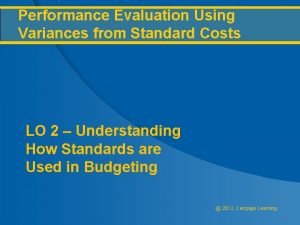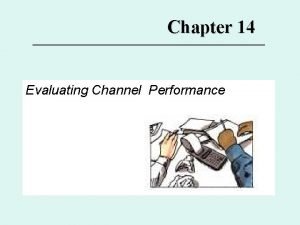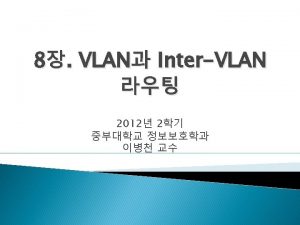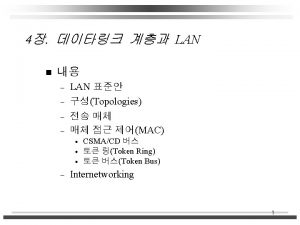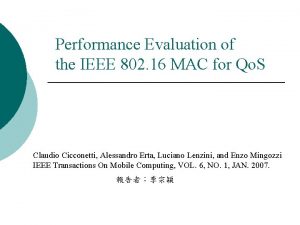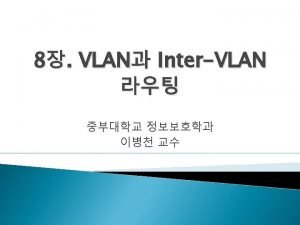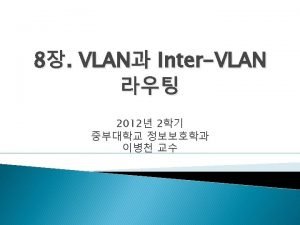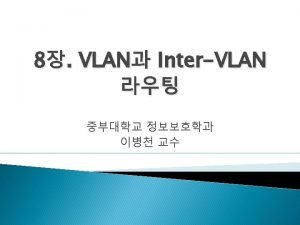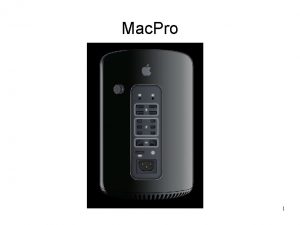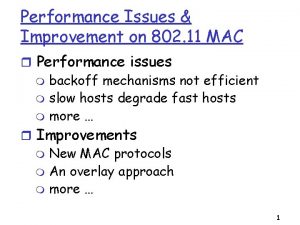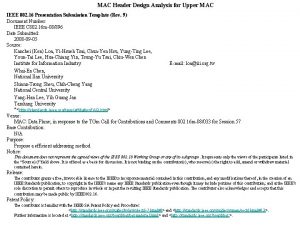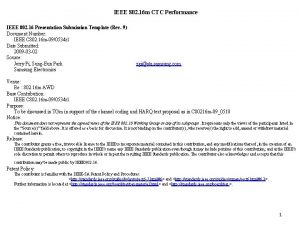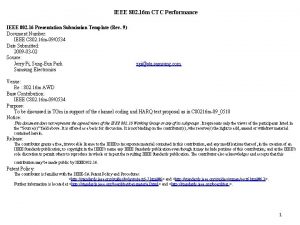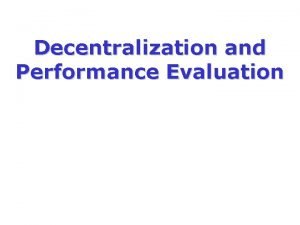Performance Evaluation of IEEE 802 15 4 MAC


















- Slides: 18

Performance Evaluation of IEEE 802. 15. 4 MAC for Low Rate Low Power Wireless networks Gang Lu Bhaskar Krishnamachari Cauligi S. Raghavendra Department of Electrical Engineering-Systems April 9, 2004 http: //ceng. usc. edu/~anrg/ 1

Outline • Overview of IEEE 802. 15. 4 TM/Zig. Bee. TM • Physical Layer • MAC Layer – – Super frame Structure CSMA and polling GTS in CFP Synchronization • Simulation April 9, 2004 2

Introduction to LR-WPAN • Low-Rate Low-Power Wireless Networks – – – Wireless sensor networks Industrial Control and Monitoring Environmental and Health Monitoring Home Automation, Entertainment and Toys Security, Location and Asset Tracking Emergency and Disaster Response • IEEE 802. 15. 4 – A new MAC for LR-WPAN – IEEE 802. 11: an “overkill technology” – Bluetooth: high data rate for multimedia applications, small size network, high power consumption April 9, 2004 3

Features of IEEE 802. 15. 4 • 16 channels in the 2450 MHz band, 10 channels in the 915 MHz band, and 1 channel in the 868 MHz band • Over-the-air data rates of 250 kb/s, 40 kb/s, and 20 kb/s • Star or peer-to-peer operation • Allocated 16 bit short or 64 bit extended addresses • Allocation of guaranteed time slots (GTSs) • Carrier sense multiple access with collision avoidance (CSMA-CA) channel access • Fully acknowledged protocol for transfer reliability • Low power consumption • Energy detection (ED) • Link quality indication (LQI) April 9, 2004 4

Network Topologies IEEE 802. 11 only describes the MAC and PHY layer. Upper layers are designed by Zig. Bee which has not be released. April 9, 2004 From ``Home Networking with IEEE 802. 15. 4: A Developing Standard for Low-Rate Wireless Personal Area Networks", Ed Callaway, Paul Gorday and Lance Hester, IEEE Communications Magazine Aug. 2002 5

PHY: Channel Structure From ``Home Networking with IEEE 802. 15. 4: A Developing Standard for Low-Rate Wireless Personal Area Networks", Ed Callaway, Paul Gorday and Lance Hester, IEEE April 9, 2004 Communications Magazine Aug. 2002 6

PHY Features Power feature of CC 2420 Rx Tx April 9, 2004 19. 7 m. A P=-25 d. Bm 8. 5 m. A P=-15 d. Bm 9. 9 m. A P=-10 d. Bm 11 m. A P=-5 d. Bm 14 m. A P=0 d. Bm 17, 4 m. A • • • Both PHYs are based on DSSS 2. 4 GHz PHY provides 250 kbps 868/915 MHz PHY provides 20 kbps and 40 kbps respectively Sensitivity: -85 d. Bm for 2. 4 GHz and -92 d. Bm for 868/915 MHz Range: 10 -20 m From ``Home Networking with IEEE 802. 15. 4: A Developing Standard for Low-Rate Wireless Personal Area Networks", Ed Callaway, Paul Gorday and Lance Hester, IEEE Communications Magazine Aug. 2002 7

MAC: Super frame • Beacon Mode: – – – • PAN coordinator broadcasts a beacon which tells the superframe structure CAP: Contention Access Period CFP: Contention Free Period GTS: Guaranteed Time Slot Turn off radio in inactive period to save energy Beaconless mode – Just CSMA-CA April 9, 2004 8

Collision Access Period • Transaction – either the coordinator needs to indicate in its beacon when messages are pending for devices – or the devices themselves need to poll the coordinator to determine whether they have any messages pending. • CSMA-CA – Power consumption during the backoff period – IEEE 802. 15. 4 provides a “Battery Life Extension” (BLE) mode which limited the backoff exponent to 0 -2. – Reduced the idle listening period April 9, 2004 9

GTS in CFP • A device can request dedicated bandwidth to achieve low latency • Used only for communication between PAN coordinator and devices • PAN coordinator maintain and assign the GTS slots used by devices • A device enables its radio at a time prior to the start of the GTS and transmit during GTS without CSMA-CA April 9, 2004 10

Synchronization • PAN coordinator transmits beacon frames periodically to announce the superframe structure • A device need to know the superframe before any data transmission • Synchronization methods: – Tracking • Enable its radio periodically to receive the beacon – Non-tracking • Enable its radio when necessary and search for the next beacon April 9, 2004 11

Simulation • Only evaluate the beacon mode on star topology • Radio parameters in table 1 • 7 X 7 grid with 49 node • 4 m distance between adjacent node • CBR traffic with 50% randomization April 9, 2004 12

CSMA-CA April 9, 2004 13

Duty Cycle-Energy April 9, 2004 14

GTS in CFP April 9, 2004 15

Synchronization Tracking April 9, 2004 Non-tracking Tracking: Enable radio periodically to receive the beacon Non-tracking: Enable radio when necessary and search for the next beacon 16

Synchronization Crossover curve April 9, 2004 Analysis & Simulation result 17

Conclusion • An overview of IEEE 802. 15. 4 • Evaluation of MAC – CSMA-CA in CAP – Energy Latency Tradeoff of Duty Cycle – Energy Latency Tradeoff of GTS in CFP – Tradeoff between tracking and non-tracking synchronization • Plan to make NS-2 model available online April 9, 2004 18
 Bridges from 802.x to 802.y
Bridges from 802.x to 802.y Bridges from 802.x to 802.y
Bridges from 802.x to 802.y Ieee 802 family
Ieee 802 family Ieee 802 3 compliance
Ieee 802 3 compliance Wlan standards
Wlan standards Arquitetura ieee 802
Arquitetura ieee 802 El 802
El 802 Ieee 802 standard
Ieee 802 standard Bluetooth ieee 802
Bluetooth ieee 802 802 ieee
802 ieee Ieee 802
Ieee 802 The real macbeth king of scotland
The real macbeth king of scotland Mac mac o kok dac
Mac mac o kok dac Usmc master brief sheet
Usmc master brief sheet Performance evaluation using variances from standard costs
Performance evaluation using variances from standard costs Da form 7222
Da form 7222 Measurement and evaluation in human performance
Measurement and evaluation in human performance Importance of evaluating channel member performance
Importance of evaluating channel member performance Evaluation for unit 6
Evaluation for unit 6














